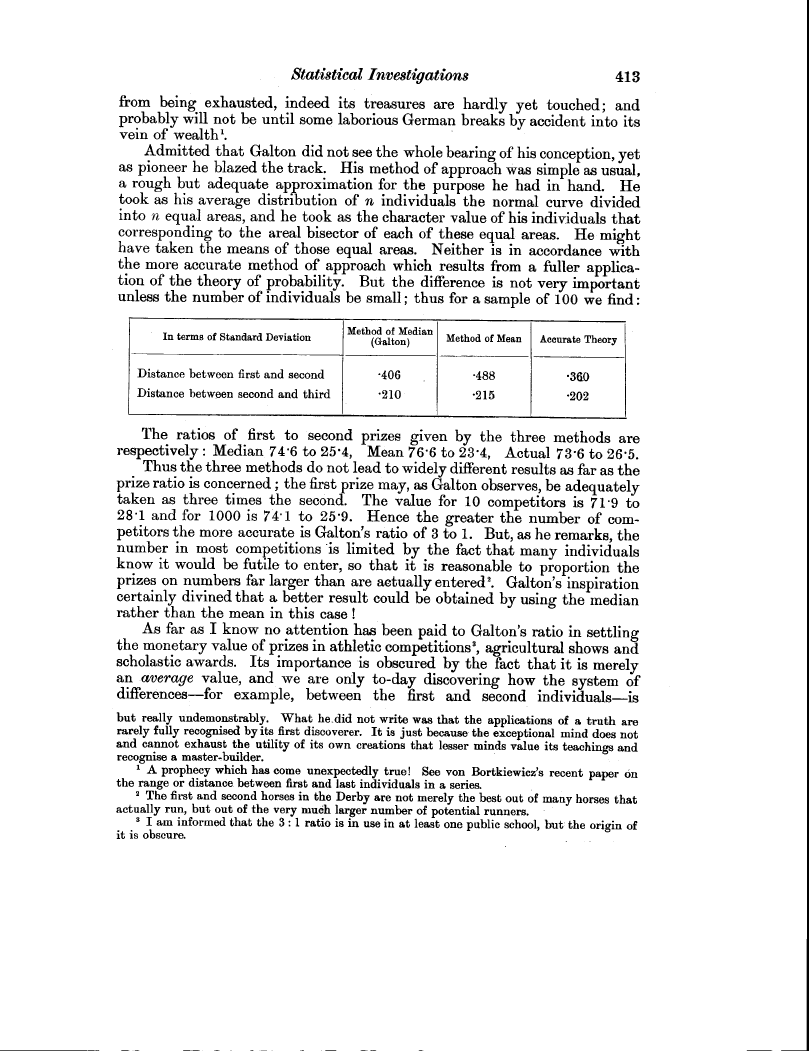Statistical Investigations 413
from being exhausted, indeed its treasures are hardly yet touched; and probably will not be until some laborious German breaks by accident into its vein of wealth'.
Admitted that Galton did not see the whole bearing of his conception, yet as pioneer he blazed the track. His method of approach was simple as usual, a rough but adequate approximation for the purpose he had in hand. He took as his average distribution of n individuals the normal curve divided into n equal areas, and he took as the character value of his individuals that corresponding to the areal bisector of each of these equal areas. He might have taken the means of those equal areas. Neither is in accordance with the more accurate method of approach which results from a fuller application of the theory of probability. But the difference is not very important unless the number of individuals be small ; thus for a sample of 100 we find
|
In terms of Standard Deviation |
(GaIton Method t) Median |
Method of Mean |
Accurate Theory |
|
Distance between first and second |
406 |
488 |
360 |
|
Distance between second and third |
210 |
215 |
202 |
The ratios of first to second prizes given by the three methods are
respectively : Median 74.6 to 25.4, Mean 76.6 to 23.4, Actual 7 3.6 to 26.5.
Thus the three methods do not lead to widely different results as far as the prize ratio is concerned ; the first prize may, as Galton observes, be adequately taken as three times the second. The value for 10 competitors is 71.9 to 28.1 and for 1000 is 74.1 to 25.9. Hence the greater the number of competitors the more accurate is Galton's ratio of 3 to 1. But, as he remarks, the number in most competitions 'is limited by the fact that many individuals know it would be futile to enter, so that it is reasonable to proportion the prizes on numbers far larger than are actually entered 2. Galton's inspiration certainly divined that a better result could be obtained by using the median rather than the mean in this case !
As far as I know no attention has been paid to Galton's ratio in settling the monetary value of prizes in athletic competitions3, agricultural shows and scholastic awards. Its importance is obscured by the fact that it is merely an average value, and we are only to-day discovering how the system of differences-for example, between the first and second individuals-is
but really undemonstrably. What he.did not write was that the applications of a truth are rarely fully recognised by its first discoverer. It is just because the exceptional mind does not and cannot exhaust the utility of its own creations that lesser minds value its teachings and
recognise a master-builder.
1 A prophecy which has come unexpectedly true! See von Bortkiewicz's recent paper on the range or distance between first and last individuals in a series.
2 The first and second horses in the Derby are not merely the best out of many horses that actually run, but out of the very much larger number of potential runners.
3 I am informed that the 3 : 1 ratio is in use in at least one public school, but the origin of it is obscure.

